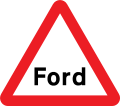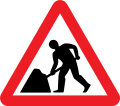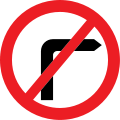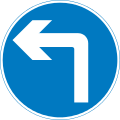Worboys Committee
The Worboys Committee was formed by the British government in July 1963 to review signage on all British roads.[1] This was in response to two articles published in 1961 by graphic designer Herbert Spencer, illustrating the shortcomings of non-motorway British road signs.[2]

The committee was chaired by Sir Walter Worboys of ICI.[3] T. G. Usborne of the Ministry of Transport had charge of proceedings, and Jock Kinneir and his assistant (and later business partner) Margaret Calvert were commissioned as designers.[2]
In 1963, the committee released Traffic signs: report of the committee on traffic signs for all-purpose roads, which completely revised road signs in Britain, with an emphases on symbols alone and adopting standard colour and shape practices used in mainland Europe, adoption of a new typeface, called Transport. On 1 January 1965, the Traffic Signs Regulations and General Directions (TSRGD), the legal framework for road signs in Britain, was revised to adopt the proposed changes in the report.[2]
Pre-Worboys sign flaws
The report found eight primary flaws in the United Kingdom's traffic signage.
(a) roadside signs are too small to be readily recognisable as such and to be easily read by drivers travelling at the normal speed of traffic;
(b) they do not have a simple, integrated appearance;
(c) the more important signs are not readily distinguishable from the less important at long range;
(d) they are often not effective at night;
(e) they are different from those used on the continent of Europe and only those who can read English can fully understand them;
(f) they are often mounted too high, particularly in rural areas;
(g) they are often badly sited in relation to junctions; and(h) there is insufficient continuity of place names on directional signs.
— Worboys Committee, Traffic signs: report of the committee on traffic signs for all-purpose roads (1963)[4]
Most pre-Worboys signs consisted of two signs: the top one was one of four designs, a red 'triangle', 'disk', 'ring' or 'triangle in ring' that identified the sign's type; the second lower sign identified the hazard or restriction. The lower sign was approximately 1 foot 9 inches (21 in; 530 mm) tall and approximately 1–2 feet (12–24 in; 300–610 mm) wide. The majority also lacked any larger dimensions for use on higher-speed roads. The new Worboys designs for warning signs had a minimum height of 24 inches (610 mm), and three additional sizes:30 inches (2 ft 6 in; 760 mm), 48 inches (4 ft 0 in; 1,200 mm), 72 inches (6 ft 0 in; 1,800 mm)[lower-alpha 1] for higher-speed roads or special situations that warranted a larger sign. Regulatory signs were 24 inches (610 mm), and greatly simplified through use of symbols eliminating wordy signs .[lower-alpha 2][5]
"Traffic signs – 1963"
The report found existing road signs to be completely obsolete relative to increasing numbers of motor vehicles and motor vehicle speeds and made over a dozen key recommendations:[4]
- Letters sizes should be increased compared to existing signs and up to 10 inches (250 mm) on high-speed roads. Letters should also be Sentence case, not in all capital letters.
- Signs should reflect the design of traffic signs used in the rest of Europe, with an emphasis on using symbols and the shape of sign to convey the message, not words. Further, doing away with the previous standard sign designs consisting of two separate signs to form a complete sign.
- Provision of Give way and stop signs at junctions on minor roads when they meet primary routes.
- More usage of sign illumination, and improvements to existing standards and increased use of Cat's eyes (roadway reflectors).
- Uniformity in the deployment and use of traffic signs.
- Clearer marking of primary routes, through use of colour coded signs to aid drivers in identifying them if they are unfamiliar with an area.
- Direction signs should be colour coded, with primary routes having green signs with white words and yellow route numbers. Non-priority roads should be black and white.
The report suggested approximately 136 signs [lower-alpha 3] The designs proposed in the report were received further revisions before the 1964 TSRGD, as the proposed prohibited signs featured a 'slash' on signs like 'Buses prohibited', 'All motor vehicles prohibited'; a minimum speed limit sign that was not included; a rectangular 'Pass either side' sign; and the designs of symbols, like 'telephone' and 'opening bridge ahead'.
| Pre-Worboys sign | Type of sign | Meaning | Sign number[lower-alpha 4] | Worboys Committee sign |
|---|---|---|---|---|
 |
Warning |
Cross roads ahead |
504 |
.svg.png) |
 |
Warning |
554 |
 | |
 |
Warning |
Road works ahead |
564 |
 |
.svg.png) |
Regulatory |
No Entry |
616 |
 |
 |
Regulatory |
No right turn |
612 |
 |
 |
Regulatory |
Turn left |
609 |
 |
 |
Regulatory |
Keep to left |
610 |
 |
_-_1944.svg.png) |
Direction |
Approach direction sign for a junction where two Class 1 (A-roads) roads cross. |
704 |
 |
_-_1944.svg.png) |
Direction |
A direction sign used at junctions, indicating route numbers and primary destinations. |
713 |
 (Primary route)  (Non-primary route) |
Anderson Report
The Worboys Committee was tasked with designing signs for 'all-purpose roads' which were open to any road user, including motor vehicles, animal-drawn vehicles and pedestrians. Signs for motorways, which were designed strictly for motor vehicles, were needed in 1958 upon the opening of the Preston By-pass, the first 'motorway'. A separate committee, known as the 'Anderson Committee', was assembled to design signage for future motorways, as the flaws of existing signs had already been observed with drivers at 70 miles per hour (110 km/h) struggling to interpret them. The committee took inspiration from the United States and Germany who were designing their own motorways and signage to go with them. In 1962, they published Motorway Signs: Final Report of Advisory Committee for Traffic Signs on Motorways which laid out their designs for motorway signage.[7]
Ultimately, motorway directional and informational signs were included in the 1964 TSRGD. The warning and most regulatory signs proposed in the report were not adopted for use,[lower-alpha 5] and the designs proposed in the Worboys report were used instead in future motorway projects.[5]
See also
- Transport (typeface) – proposed by the report and still used in Britain for road signs
- Road signs in the United Kingdom
Notes
- 72 inch signs were only prescribed for Junction and roadway narrows signs. Other warning signs were only prescribed up to 48 inches tall.
- The 1944 weight restriction sign consisted of this message: "One vehicle only on bridge Maximum weight 15 tons speed limit 5 M.P.H.", on a sign that was about 2 feet (610 mm) square. The replacement, Sign 626, consisted of just "XX Tons" in a 24 inches (610 mm) circle, with an additional "Only one vehicle on bridge" plate if necessary.
- This count excludes supplementing plates.
- From the 1964 TSRGD. Some sign numbers have since changed.
- The designs were often similar, with the consistent difference being the inclusion of words and colour scheme; A non-reflective red background, with a reflective red border that outlined the shape of the sign and a reflective white symbol.
References
- "Hansard: Worboys Committee and New Traffic Signs". 3 July 1963. Retrieved 29 June 2011.
- "Origin of British road sign design". Design Museum. Archived from the original on 23 November 2010. Retrieved 29 June 2011.
- "Hansard: Traffic Signs Committee Report". 13 March 1963. Retrieved 29 June 2011.
- Committee on traffic signs for all-purpose roads (Worboys Committee); Ministry of Transport (1963). "Traffic signs: report of the committee on traffic signs for all-purpose roads". Archive.org. Her Majesty's Stationery Office. Retrieved 14 July 2019.
- Ministry of Transport (20 November 1964). The Traffic Signs Regulations and General Directions 1964. Her Majesty's Stationery Office.
- Ministry of War Transport (1946). Report of the Departmental Committee on Traffic Signs - 1944. Her Majesty's Stationery Office.
- Advisory Committee on Traffic Signs for Motorways (Anderson Committee); Ministry of Transport (1962). "Motorway Signs: Final Report of Advisory Committee for Traffic Signs on Motorways". Archive.org. Her Majesty's Stationery Office. Retrieved 14 July 2019.
External links

- The Worboys Report at Roads.org.uk
- Traffic signs: report of the committee on traffic signs for all-purpose roads – a copy of the 1963 report, at the Internet Archive
- Motorway Signs: Final Report of Advisory Committee for Traffic Signs on Motorways - a similar 1962 report for motorway signage, some of which was adopted by Traffic Signs report, at the Internet Archive